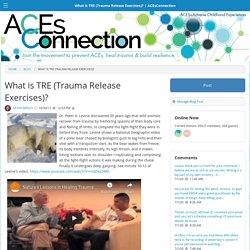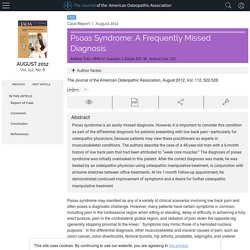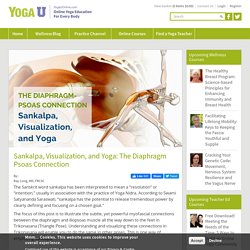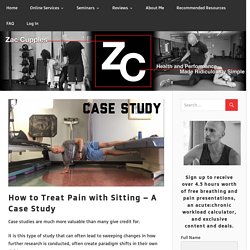

Superior T4. Recent E-mails - On Neuromuscular Deficits in Individuals Who Cannot Inhale Through Their Nose… Ep. 5 - Further explanation on Thoracic Kyphosis - PRIVY - PRI Video for You. Ep. 5 – Further explanation on Thoracic Kyphosis September 5, 2017 Posted in Primary Course Concepts, Trial Video Tags: Postural Respiration, Back, Thoracic Kyphosis « Ep. 4 – Why do we have the feet on the wall for the 90-90?

Ep. 6 – An Advanced Discussion on Cervical Relationships with Foot and Ankle Instability. » 2 comments Add a comment... Your email is never published or shared. Why You Should Sit on the Floor — Stay Strong. We as a society need to spend more time on the floor.

All humans, all cultures, throughout the ages have spent all our resting and much of our working lives on the ground in variations of a squat, kneeling or cross-legged position. Humans had found ease getting into and out of these primary floor postures until we created the comforts of modernity, which has led us to dis-ease in both form and function. Dr. Net Link New Off Season 1 5. What is TRE (Trauma Release Exercises)? Dr.

Peter A. Levine discovered 35 years ago that wild animals recover from trauma by tremoring spasms of their body core and flailing of limbs, to complete the fight-flight they were in before they froze. Levine shows a National Geographic video of a polar bear chased by biologists (just to tag him) and then shot with a tranquilizer dart. As the bear wakes from freeze, its body trembles intensely, its legs thrash, and it makes biting motions over its shoulder—replicating and completing all the fight-flight actions it was making during the chase. Finally it undergoes deep gasping. This discharges tons of stress chemicals which otherwise get frozen in the body. Taping the Diaphragm. The human body possesses the power of reacting to gravity, inertia and momentum, the primary forces of the physical world, by means of proprioception: "perceiving self.

" This proprioceptive system helps guide total-body reaction to the outside world and gives us awareness of space and time. It is a critical player in organization, function, timing and sequencing when moving! Muscle sequencing and timing are fundamental in the movement game. If you want to get from Point A to Point B, you need proximal stability for optimal distal mobility. Stability determines performance. Psoas Muscle - Why It's the Most Vital Muscle In Your Body. The psoas muscle (pronounced SO-as) may be the most important muscle in your body.

Without this essential muscle group, you wouldn’t even be able to get out of bed in the morning! In fact, whether you run, bike, dance, practice yoga, or just hang out on your couch, your psoas muscles are involved. 7 Ways to Tell if You Have a Psoas Muscle Imbalance - InSync Physiotherapy. When you have a tight (or short) psoas muscle, you may experience pain in your lower back or in your hips, especially when lifting your legs.

This is caused by the muscle compressing the discs in the lumbar region of your back. Stretching your muscles and releasing the tension on the psoas is the best way to prevent this from happening. It takes time and daily attention to keep your psoas muscles relaxed, stretched, and strong. And, while most people with psoas issues have tight psoas muscles, there are some people whose psoas muscles can be overstretched. In this case, if you stretch your psoas and it is already overstretched, you will cause more problems. InSync Physiotherapy is a multi-award winning health clinic helping you in Sports Injuries, Physiotherapy, Exercise Rehabilitation, Massage Therapy, Acupuncture & IMS. Managing a Female Patient with Left Low Back Pain and Sacroiliac Joint Pain with Therapeutic Exercise: A Case Report.
Recognizing Myofascial Pelvic Pain in the Female Patient with Chronic Pelvic Pain. The Journal of the American Osteopathic Association. A 48-year-old white man presented with a 6-month history of low back pain.

He recalled the morning when he first noticed pain in his lumbar region; he awoke to find himself “hunched over” with marked difficulty standing up straight. The pain, which shifted back and forth from his right to left lumbosacral region, was described as aching, episodic, and fluctuating in intensity. He also had occasional bouts of pain and numbness that radiated into his buttocks and down to his knees, with the right lower extremity being more frequently affected. His back felt stiff and he had an especially hard time achieving a fully erect posture after prolonged sitting. He found a position of ease by lying flat on his back with his hips flexed, knees extended, and legs resting against a wall.
Sankalpa, Visualization, and Yoga: The Diaphragm Psoas Connection. The Sanskrit word sankalpa has been interpreted to mean a “resolution” or “intention,” usually in association with the practice of Yoga Nidra.

According to Swami Satyananda Saraswati, “sankalpa has the potential to release tremendous power by clearly defining and focusing on a chosen goal.” The focus of this post is to illustrate the subtle, yet powerful myofascial connections between the diaphragm and iliopsoas muscle all the way down to the feet in Trikonasana (Triangle Pose). Psoas Syndrome - Overlooked Cause Of Back, Hip & Groin Pain. The psoas (pronounced so-as) syndrome is caused by a problem with the iliopsoas which is comprised of two muscles, the iliacus muscle and the psoas muscle which are joined by the psoas tendon.

Psoas syndrome is a problem with the muscle relating to an imbalance of muscle function. Problems of the muscle occur from strain, spasms, contracture, which is a prolonged spasm and tendonitis, which is inflammation of the tendon that attaches the muscle to bone, and bursitis, which is inflammation of the bura sac that allows smooth motion between the tendon and other structures.
Insertional tendinopathy of the adductors and rectus abdominis in athletes: a review. How to Treat Pain with Sitting - A Case Study. Case studies are much more valuable than many give credit for.

It is this type of study that can often lead to sweeping changes in how further research is conducted, often create paradigm shifts in their own right. After all, there was only one Patient H.M. One thing that I wish I saw more in case studies was the clinician’s thought process. Why did they elect to do this treatment over that, what were they thinking when they saw this? How do they tick? I was fortunate enough to have an online client of mine suggest to that I make her a case study, and it was a very rewarding experience on both fronts. My hope is that you can see how a clinician thinks first-hand, and see the challenges a clinician faces… When you can’t work with your hands.
The Problem of Sitting – Her Story. Low Back Pain - Google Books. Postural Restoration: A Tri-Planar Asymmetrical Framework for Understanding, Assessing, and Treating Scoliosis and Other Spinal Dysfunctions. 1. Introduction Recognition of inherent physiological asymmetry has not yet been applied to the understanding, assessment, or treatment of scoliosis or other spinal and postural disorders. How to fix Flared Ribs - Posture Direct. What are Flared Ribs? When you have flared ribs, the lower portion at the front of your rib cage protrudes forwards and out.
It is associated with an increased arch of the lower back. Ideally – The rib cage should feed directly into the pelvis. Repetitive strain injury of the psoas muscle in dogs - VetBloom blog. Stuart Bliss, DVM, PhD, DACVS, CCRPCharles Evans, MPT, CCRPPort City Veterinary Referral Hospital, Portsmouth, NH Repetitive overuse of the psoas is a common yet under appreciated cause of mobility impairment in the dog.
Sustained contraction, fatigue and spasm of the psoas musculature frequently develop in dogs with a wide range of orthopedic or neurologic disorders as they alter their posture to compensate for painful or dysfunctional limbs. This form of repetitive strain injury (RSI) can be difficult to recognize, yet it is a significant cause of pain and decreased mobility, especially in geriatric dogs. Strain-counterstrain is a manual therapeutic technique adapted from the field of physical therapy that can be used to treat psoas muscle strain that develops secondary to injury or surgery.
Securing the Left Hip: The Importance of Left AF/IR - PRI Trainer. In the first picture above, the pelvis is oriented to the right. Knee Pain - PRI Trainer. The knee pain in this picture is clearly being caused by the torque placed upon the knee due to the misaligned upper and lower leg bones. However, the knee pain isn’t actually a knee problem. Pain Under the Sits Bone and Hamstring Strains - Dr. Sarah Ellis Duvall.
I was thinking back to a patient from one of my internships during PT school in 2004. Craig Purdam - What about hamstring tendinopathy?! Course Notes: PRI Pelvis Restoration. Just recently attended another excellent PRI course taught by Lori Thomsen and new instructor Jesse Ham called Pelvis Restoration. The weekend was filled with great discussion about inlets, outlets, shoes, and many other pearls that helped solidify my PRI understanding. So without further ado, let’s summarize. R AIC Alternating Reciprocal Gait Reccomendations. Lateral Femoral Cutaneous Neuropathy 1. Boston Diaphragm Performance Presentation 2.
Anatomytrainsoverview. PRI Exercises - Erbst OrthoSport Physical Therapy. Top Ten Integrative Activities for L AF IR with R TR clinic. Course Notes: PRI Myokinematic Restoration. Pronated Left Foot and Supinated Right Foot in a Left AIC Pattern - PRI Trainer. If I ask someone what they feel in a standing position– where they feel their weight on their feet– they will most likely say their left arch area and their right heel/lateral border. Desired PRI Clinical Application for Right Low Trap and Right Serratus Activities. Squats and Hip Dysfunction: 2 Common Problems and How to Fix Them - Page 2. Fixing The Problem. 3.2 Causes of OP: Weak arches - The OP Clinic. 3.1 The Deep Front Line - The OP Clinic. Refresh your learning: Typical Weight Distribution of Left AIC Pattern: A Visual - PRI Trainer. Stretching Exercises for Adhesions in the Pelvic Area.
From The Outside In: This Manual Therapist Treats Endometriosis Pain, Above, Licensed Massage Practioner Marty Ryan puts his hands to work. Activate Your Glutes with Bridge Exercise Variations - Pain Free Athlete, Egoscue and PRI Certified. My favourite gluteal activation exercises – Physiospot – Physiotherapy and Physical Therapy in the Spotlight. What's Your Postural Pattern? — Integrate 360 Physical Therapy. Integrating Postural Restoration Institute Activities for the Movement Professional. Glutorial.
Unlocking Secrets of the Pelvis (Parts 1, 2, 3, 4) An Introduction to the Postural Restoration Institute. Do You Even Exhale, Bro? (Parts 1, 2, 3) Recent E-mails - On Left Medial Knee Pain During 90/90 Repositioning Exercises. Understanding Sequencing Asymmetrical Rotational Patterns PDF. Healing Hip Pain Through Gut Healing: Crazy, but Scientific. Adhesions: The Source of Pelvic Pain? Injuries and Pain in the Hip Flexor Muscle Group - DR. RUSSELL SCHIERLING. Postural Restoration of an Ironman – A Week by Week Case Study – Katie St.Clair Fitness. Left Sidelying Left Extended Adduction with Right Glute Max and Right Trunk Rotation. 1 15 left sidelying left flexed fa adduction with right extended fa abduction and left abdominal co activation 5. 7 Left Stance in Left AF IR Position from the Left AIC Pattern 2. Insertional tendinopathy of the adductors and rectus abdominis in athletes: a review. : Hip Articulations.
The Trigger Point & Referred Pain Guide. Adductors, Pudendal Nerve and Pelvic Floor Pain – Erik Dalton Blog. DIFFERENTIAL DIAGNOSIS OF DEEP GLUTEAL PAIN IN A FEMALE RUNNER WITH PELVIC INVOLVEMENT: A CASE REPORT. Supine Lower Extremity Neural Glide - CornellCast. /uncategorized/integrating-orofacial-myofunctional-therapy-and-pri-to-achieve-craniofacial-resonance/ The Right TMCC Pattern and Facial Asymmetries. Occlusion and Gait A Clinical Observation. CLINICAL APPLICATION OF THE RIGHT SIDELYING RESPIRATORY LEFT ADDUCTOR PULL BACK EXERCISE.
PRI Left AIC Right BC Beginner Example Program - PRI Trainer. The Right TMCC Pattern in Postural Restoration - PRI Trainer. Course Notes: PRI Pelvis Restoration. Hruska Clinic : News Articles : Torin's Blog. Muscles That Move the Leg. The Definitive Guide to Hip Adductor Anatomy, Exercises & Rehab. High Hamstring Tendinopathy: Avoid That Pain In Your Butt When You Run. PRI Left AIC Right BC Beginner Example Program - PRI Trainer. Correcting Common Posture For Lumbar Stenosis - ThePostureGuy. The Science. Principles of Postural Restoration for the Sports PB Summit. Postural Restoration: A Tri-Planar Asymmetrical Framework for Understanding, Assessing, and Treating Scoliosis and Other Spinal Dysfunctions. An Introduction to the Postural Restoration Institute, Part 1: The Neurological Nature of PRI – Integrative Human Performance. NSCA Coaches Conference Powerpoint Handouts.
Push, Pull, Propulsion Masek 2018 Coaches Conference.